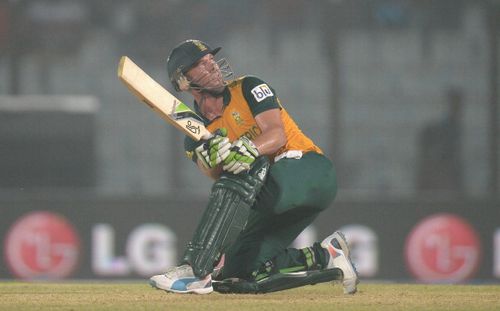
Why AB de Villiers is the best batsman in the world

If you haven’t read many analytical pieces on Abraham Benjamin de Villiers, it’s probably not your fault. If there haven’t been many analytical pieces on de Villiers over the internet, it is not the fault of the journalists either. Who would be stupid enough to analyse him whilst he’s batting and miss out on the most serene stroke play the game has ever seen, taking into account how the game has developed over the years (don’t bring Viv Richards, Don Bradman and Sachin Tendulkar in here, please. And not Damien Martyn either)?
After all, analysing De Villiers is similar to the trade of a gynaecologist – both look for problems where people ideally find pleasure. Having said that, the good news is that Absolutely Brilliant de Villiers is finally starting to show a clearly defined pattern in the way he goes about his business. The bad news? As a bowler, there is absolutely nothing you can do about it with the current ODI set of rules.
However, in typical thesis presentation style, let us establish a few facts beyond reasonable doubt before the actual theory is presented.
How AB stacks amongst other top batsmen
Since Oct 30, 2012, 36 batsmen have managed to score over a thousand runs. Among these, AB averages the highest (61.75), a whopping 5.35 runs per match more than Kane Williamson at number two (56.40). Better than Indian batting sensation Virat Kohli (52.75), his South African counterpart Hashim Amla (53.33) and Sri Lankan stalwart-in-form Kumar Sangakkara (55.69)
If this is not enough to establish his supremacy (it is, for the record), he strikes these runs at a mind boggling 111.15 runs per 100 balls. There are only three others in the list who strike it over a 100. They are the highly expected trio of Brendon McCullum (113.41) Jos Buttler (110.85) and Glenn Maxwell (122.88). The fun part, however, is that they average 32.37, 31.97 and 31.58 respectively, comparable to ‘half’ of De Villiers’.
Among those who match De Villiers (they don’t really), Williamson strikes it at 87.02, Kohli 95.83, Amla 87.46 and Sangakkara 91.09. Not only this, De Villiers also has the best strike rate from overs 41 to 50 in the history of the game, and for all purposes remains the only player to strike it above 200 (minimum threshold of 500 runs).
Now that it is firmly established as to who the boss is, let us now reveal the mystery of 30th Oct, 2012. This is the date the fielding restrictions were changed and the maximum fielders allowed during the non-powerplay overs in the outer ring were reduced from five to four.
De Villiers before and after change in fielding rules
There are two aspects to this point, the first being De Villiers up to 30th Oct, 2012; and the other being ever since.
|
Innings |
Runs |
Highest Score |
Average |
Strike Rate |
100s |
50’s |
|
|---|---|---|---|---|---|---|---|
|
De Villiers since Debut upto 30th Oct 2012 |
127 |
5168 |
146 |
49.21 |
93.15 |
13 |
29 |
|
De Villiers since 30th Oct 2012 – Present |
49 |
2532 |
162* |
61.75 |
111.15 |
7 |
14 |
In terms of percentage, his average and strike-rate have increased by 25.5% and 19.3% respectively. Again, the fact that he has substantially and exponentially improved as an ODI batsman stands proved without doubt.
But all this is moot. De Villiers just got better with time and so his numbers must have improved.
Glad you asked. As we have already established, De Villiers is one of the best in the business when it comes to overs 40-50. It is hence logical to assume that De Villiers will be an immensely destructive T20 player. Contrary to popular assumption, he isn’t.
There has been no concurrent improvement in his numbers in the T20 format.
De Villiers, in the same period since Oct 2011, averages 22.50 from 12 innings with a solitary half century. He does strike it 144.23, but the figures effectively mean that he scores 22.50 off 16 balls, which is really below par. To add some spice, Tim Bresnan has averaged and played faster than De Villiers during this period, while over 50 players average more than him, including Samuel Badree (minimum 10 matches).
To be fair, De Villiers never hit the right chord when it comes to the shortest format. An overall average of 22.37 at 125.24 and merely 5 fifties in 54 innings doesn’t make a good CV at all.
Any guesses as to why? In ODIs, De Villiers rotates the strike really well and when it’s time to go, unleashes like a lethal beast. What makes T20 different? Here’s a hint – T20 allows 5 men outside the ring as opposed to 4 when it comes to the ODI format.
In fact, not only International T20s, he averages a shade below 30 in domestic T20s as well, at a decent strike rate of 136.17 – not what you expect from one of the most destructive ODI players doing the rounds today.
But this by no stretch of the imagination implies that AB cannot be the most destructive T20 batsman in the world. Rather, this very phenomenon fits into our theory very smugly.
AB is not too interested in T20; it is pretty much an open secret by now. SA have played 24 games during this period, De Villiers has been conspicuous by his absence in 11 of those.
Could he have been the best T20 player in the world if he wanted? Probably. But if anything, it goes on to show he has modelled his game to suit the longer formats of the game - a whiff of fresh air in a generation obsessed with fame and the IPL
Ramp it up, AB

Right then, after a lot of theorems ancillary to the fact, let’s get down to business. The theory talks precisely about this point – De Villiers is such a destructive batsman solely because of his inhuman control over the ramp shot. Indeed, he is titled Mr. 360 degrees these days, but his dismissal whilst employing the reverse sweep against Ireland is further testament to the fact that he is not as adept with his ‘other’ unconventional shots as he is with the ramp.
Not to insult anyone’s intelligence, the Ramp shot is the scoop over square or fine leg to balls that are very full. If you have followed De Villiers even slightly, the shot instantly springs to mind.
Traditionally, when the batsman is looking to slog it out, bowlers employ the traditional field – long on, long off, deep mid wicket and deep cover are outside the ring and bowl full and straight. What does De Villiers do? He nonchalantly keeps ramping it over fine leg. Now, if you change the field, there will be the ‘traditional’ gap and De Villiers is simply too good to not get a boundary with his conventional batting style.
While most batsmen feel the need to take the fielder on, De Villiers simply plays it into the gaps and scores with no risk whatsoever. In fact, the ramp comes as smoothly to De Villiers as any other conventional stroke in the world, say the cover drive. You cannot bowl short to him, he will tonk you out of the park. You cannot get deep cover in and bowl on the body, he will make room and scoop in over the infield, you cannot bowl outside off and keep an offside field as he will keep ramping you then.
De Villiers is not as strong as Chris Gayle. At times he has holed out in the deep. Which is why he would rather play the field and get the chanceless boundary rather than taking on the fielder. Cowardice? Nah, brilliance!
Survival of the fittest
The new ODI rules may be harsh on the bowlers, but to say that De Villiers is such a good player only because of the field restrictions is as foolish a statement as it gets and this is nowhere near what the theory claims.
Rather it’s about Charles Darwin’s, “Survival of the Fittest” theory, which states that as the world changes, you have to adapt to the changing world as well, or you will perish. AB de Villiers has adapted to the new rules way better than any other player in the world – batsman or bowler. He is so good that had the rules not changed, he’d have come up with another mind shattering method to score runs.
But as for now, what De Villiers does is close to unstoppable and menacingly lethal. Neither bowlers nor team think-tanks seem to have come with a definite plan to counter this onslaught yet, and to be fair, it probably will need some doing.
But you never know, the magician probably has a few more tricks up his sleeve even before this one is successfully countered.